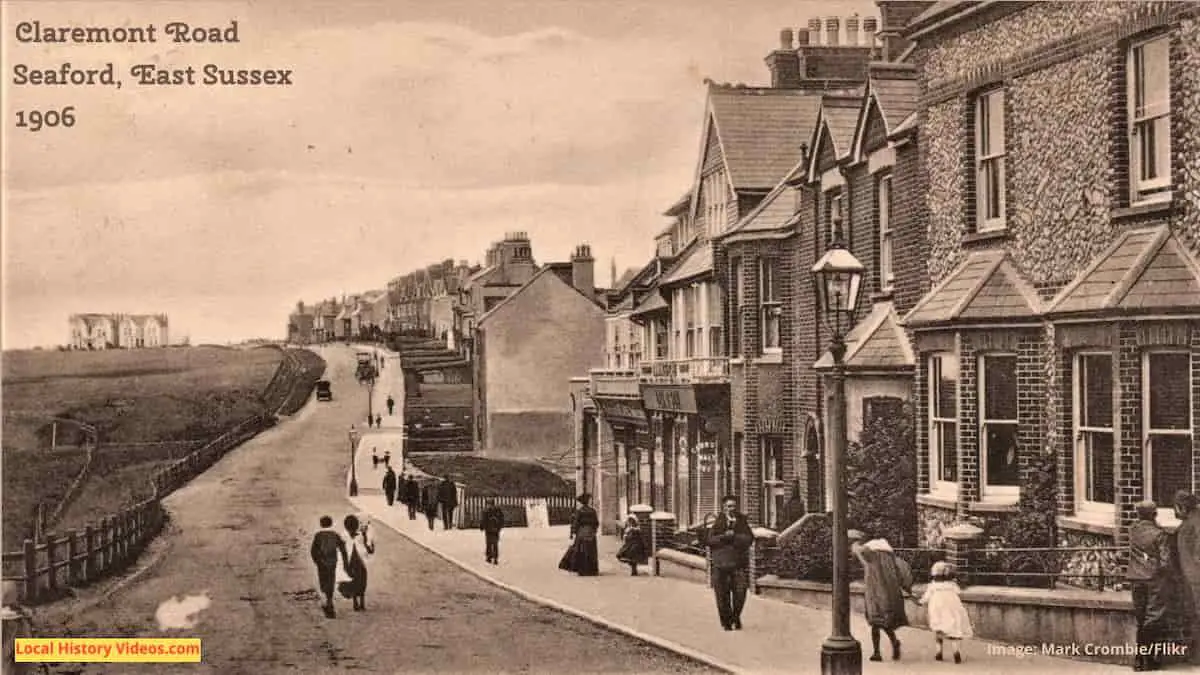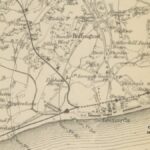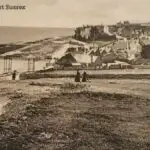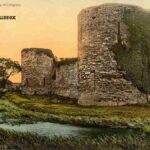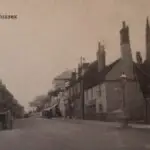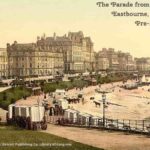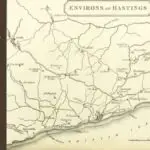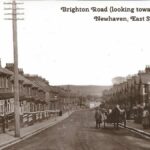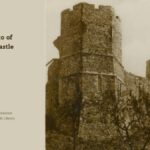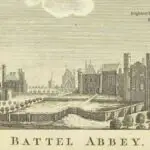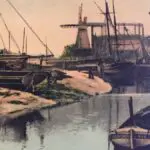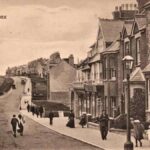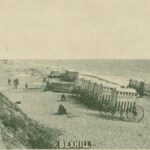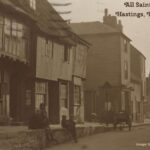Glimpse history through old images of Seaford, East Sussex, England.
WWI Soldiers’ Club
Seaford’s Soldiers’ Club was opened by General Collumb during the Great War, later known as World War I.
Club At Seaford Opened By General Collumb (1914-1918) – British Pathé on YouTube
WWI Military Sports
Presumably Seaford’s Soldiers’ Club organised these military sports during the Great War era, in which bare chested men on horseback tried to knock each other off their horse.
Military Sports At Seaford (1914-1918) – British Pathé on YouTube
Stormy Seas 1949
The stormy seas and debris scattered across the beach opened the newsreel from January 1949, which then moved on to the bus swept into the river at Shoreham.
Storms In January (1949) – British Pathé on YouTube
Stormy Seas 1959
After seeing the waves breaking at the Pier in Brighton, the newsreel moves to Seaford’s seafront.
Rough Seas (1959) – British Pathé on YouTube
Stormy Seas 1962
On the 12th February 1962, rough seas sprayed over the coast road, creating hazardous conditions for motorists.
Rough Seas (1962) – British Pathé on YouTube
A Bit of Seaford History
Extract from: A handbook for East-Bourne and Seaford, and the neighbourhood, by George Frederick Chambers
Published in 1883
Pages 98 – 103
WHAT East – Bourne was , say , 30 years , Seaford is now – not exactly a town , not exactly a village . Relatively to its various Sussex rivals it once held a much more conspicuous place than it now does . The river Ouse which now enters the sea at Newhaven , formerly did so at Seaford , and then Seaford had some pretentions to being a seaport town , but it is nothing of the kind now . Newhaven has grown into a port , whilst Seaford is merely a small summer watering – place .
The diversion of the Ouse was due to a great storm in the reign of Elizabeth , and presumeably in 1570 . The river which between Newhaven ( till then called Meeching ) and Seaford followed a course nearly parallel to the sea beach , on the occasion in question broke through its right bank , and formed a new channel which it never afterwards forsook until the existing cut was made , artificially , somewhat to the W. This event was a blow of course to Seaford from which it never re covered , but the construction of the railway to Seaford in 1864 set it on its legs again in some degree .
Seaford is a Cinque Porte affiliated to Hastings and ranking amongst the 7 members or limbs of Hastings , Pevensey standing second .
As a Cinque Port , Seaford enjoys sundry privileges , and once was called upon to bear sundry burdens inci dental to those privileges . It obtained a charter in 35 Henry VIII . , ( 1544 ) , under which it is still governed by a Bailiff and Freemen some of whom , under the name of Jurats , act as assessors to the Bailiff in the administration of justice . This charter is still preserved and is in the custody of the Town Clerk , I. Gell , Esq . , of Lewes . It is a fine specimen of caligraphy . ” The Bailiff is annually elected on Michaelmas Day with the following formalities . At the summons of the Church bell the assembly of Freemen takes place in the town hall , and after the pro formâ business has been gone through , the freemen – leaving the jurats behind them on the bench -retire in a body to a certain gate post near West House , and there elect their chief officer for the year ensuing . The motive for this singular proceeding seems to be the prevention of unfair influence on the part of the magisterial body .
The townsmen are attended on this occasion by the sergeant – at – mace in his proper costume , bearing the ensign of the Bailiff’s authority in the shape of a small mace of silver , which is ornamented with the arms of Queen Elizabeth .
The procession commences at a place the Old called Tree , where it appears the town pillory anciently stood , as it is called in old documents ‘ The Pillory Tree . ‘ The place of execution , or rather the perquisite of the finisher of the law , ‘ is still indicated by the namecof a piece of landccalled the ‘ Hangman’s Acre . ‘ Asca corporation , Seaford still appoints its Recorder , an officer who has at present neither duties nor emoluments . “
( Lower : Suss . Arch . Coll . vi . , 89. )
It returned two members to Parliament from 1400 , 1298 till and from 1641
till it was disfranchised by the Reform Act of 1832 . The first William Pitt sat
for the borough 1747-54 , and Canning in 1827 for a few weeks before his death .
Grounds are not wanting for the opinion that Seaford was a place of repute even in Saxon times . It has been by some authorities identified with Mercredesburn ( mear Sea crædford) the site of Ella’s famous battle with the Britons in 485 . ( H. L. Long , Suss . Arch. Coll . vii . 75.)
There is a picture of Seaford by Collins , R.A. , in the South Kensington , Museum .
The borough seal is a curious relic . On the obverse is an Eagle rudely executed , and the following legend in Roman and Gothic characters mixed : -SIGILLVM BURGENSIVM : De saFFORDIA On the reverse is a ship , and the following words : -WITH SVTTONII ** ET * CHYNGTON .
These two inscriptions may be thus rendered : – ” The Seal of the Burgesses of Seaford with Sutton and Chyngton , ” The two last names are those of 2 properties at the E. end of the parish . This seal is of 2 distinct dates . The obverse is of the 13th century , but the re verse is of much more modern and may possibly have been cut when Henry VIII’s charter was granted .
The Bailiff has an official seal of his own , smaller and very rude .
(Both are engraved in Sass . Arch . Coll . i . )
In the reign of Edward III . many attacks were made on Seaford by the French , and much mischief was done by them .
Another great event in its history was the outbreak of the ” Black Death ” in 1348 , which decimated the population and other wise injured the prosperity of the place .
In 1545 the French under Claude D’Annbault High Admiral , made a raid on Seaford , but were repulsed by a Sussex celebrity , Sir Nicholas Pelham .
The former importance of Seaford is attested by the fact that it furnished in 1347 to the siege of Calais 5 ships and 80 men , whilst Hastings supplied only the same number of ships , and only 16 men more . James I. in the 4th year of his reign conferred the Lordship
of Seaford on the Lord Mounteagle of Gunpowder – Plot celebrity , for his ” good service . ” This is not described , but the inference is obvious .
The Seaford coast was once famous alike for wrecks , wreckers , and smugglers . In 1058 a Flemish vessel was driven ashore near Seaford . On board of her was one Balgerus , a monk of St. Winocs – Bergue , who is described as ” fidelis fur et latro bonus . ” It would almost seem that he came to justify these appellations , for he stole from the neighbouring monastery of St. Andrew certain relics alleged to have belonged to St. Lewinna , an early British convert belonging to Sussex , martyred by the pagan Saxons . Nothing is known as to the whereabouts of this monastery , but possibly it was at Lewes , and possibly also Lewinna gave her name to , or received it from Lewes . ( Suss . Arch . Coll . i . 46. )
But Lower thinks that for ‘ monastery ‘ we must read ‘Church’ and that the narrative applies to St. Andrew’s Church , Alfiston.
On Jan. 6 , 1800 , H. M. S. Brazen , 18 . was stranded on the Ave rocks , off this coast ; out of a crew of 105 officers and men there was but one man saved . A stunted obelisk in Newhaven Churchyard , now much weather – worn , records the catastrophe .
The bathing at Seaford is not good , for the sea rises and falls only within narrow limits , and a sandy bottom is seldom to be had .
The relics of antiquity dug up at Seaford have not been numerous .
About 1823 a Roman cemetery was discovered at a place called Green Street , on the estate of Major W. T. Harison , of Sutton . Many sepulchral urns were found there . The following engraving represents 4
of them . Green Street is about 1/2 m . E. of Corsica Hall ( See post ) , along the valley .
In February , 1854 , a fine medal of Antonia , the daughter of Marc Antony , was found in the shingle below high water mark . It was of pure gold , and weighed 5dwts 38grs. On the obverse were the words ANTONIA AVGUSTA , and on the reverse SACERDOS DIVI AVGVSTI . ( Suss . Arch . Coll . vii .74)
In the summer of 1856 , a boy , prowling about at the mouth of the Cuckmere , observed protruding from a mass of earth , which had recently fallen from the cliff , a Roman urn , represented in the annexed cut . Fancying he had fallen upon a ” crock of money , ” in his haste he broke the urn . His anticipation not being realised , he gathered up the fragments and took them to a local archæologist . They were easily pieced together and found to make a vessel 9in high . ( Suss . Arch . Coll . ix . 368. )
On May 22 , 1858 , a remarkable piece of Mediæval pottery was brought to light in digging the foundations of the new School . It is 11in long and 8 high , and appears to be intended for a stag .
On each of the sides are rude figures representing boars attacked by animals which presumeably are dogs .
Only one other relic at all resembling this has ever been found in England , and , as that was discovered at Lewes , we may infer that both are the production of the same workman, and he a resident in Sussex . This object is now in the
Archæological Museum at Lewes . ( W. Figg , Suss . Arch . Coll . , x . 193. )
In 1826 Mr. Charles Rose Ellis was created by Canning , Baron Seaford . The title is now held by Lord Howard De Walden in right of his mother .
The custom of Borough English prevails at Seaford : in virtue of this , property descends to youngest sons .
The parish of Seaford contains 2235 acres chiefly of Down land . The town is remarkably compact. Its population of 1357 souls resides with in a small area , roughly quadrilateral in figure , which scarcely exceeds 1/4 m . in any direction . With the exception of Pelham Place on the W. , looking towards Newhaven , and some clusters of houses on the N. , near the railway station , the streets are crooked and narrow , and the houses low and small . Pelham Place , however , with its gaunt stuccoed houses is an undoubted disfigurement to the town .
Villas , not long London – like rows of cramped houses , are needed at Seaford .
Directly opposite the town the sea has receded , leaving a long bar , part of which has been fashioned into a sort of promenade . It generally happens that once in every 4 or 5 years the sea washes over this bar on the occasion of a very high tide , and floods the reclaimed meadows and the lower part of the town .
A noteable instance of this occurred on Nov. 15 , 1875. The combination of a heavy gale with a high spring tide led to a frightful inundation .
All the lower part of the town was flooded , many houses were wrecked , and an immense destruction of property took place . No such disaster had been known in modern times .
At the E. end of the bar in question is a Martello tower numbered 74 , the last of the chain round the coast of Kent and Sussex . It was designed for one gun and 25 men , and cost 18,000l , but is empty . Behind this tower is a ” level , ” used as a creation ground . It belongs to the corporation and is called The Bemblands , a corruption of Beamelands , spoken of in an Elizabethan Grant , dated 1592. ( Suss . Arch . Coll . vii . 80. )
A few hundred yards W. of the tower there was once a small battery , but it has been reduced to ruins , by successive great storms . The site and ruins were sold in 1869 to a private individual .
The town – hall should be visited , not for its architectural features , but as a relic of primitive antiquity .
Justice is administered within its walls at stated times .
In the upper part of the town is an open space belonging to the Corporation and called the Crouch . This name is supposed to come from crux , it being a small green with paths running obliquely across it which form a sort of St. Andrew’s cross , thus : X ; or perhaps a cross might have stood there .
A great event in the modern history of Seaford happened on Sept.
19 , 1850. On that day an enormous mass of cliff at the E. end of the town , and estimated at 200,000tons was blown down into the sea by gunpowder with the view of forming a breakwater to protect the beach opposite the town from the encroachments of the sea . Some of the débris remains , but much of it has been washed away , and the plan can only be described as a partial success having regard to the object aimed at .
Many more pages can be accessed online for free
More about East Sussex
- Old Images of Wannock, East Sussex
- Old Images of St Leonards-on-Sea, East Sussex
- Old Images of Crowhurst, East Sussex
- Old Images of Rottingdean, East Sussex
- Old Images of Pevensey, East Sussex
- Old Images of Hailsham, East Sussex
- Old Images of East Sussex, England
- Old Images of Winchelsea, East Sussex
- Old Images of Newhaven, East Sussex
- Old Images of Lewes, East Sussex
- Old Images of Crowborough, East Sussex
- Old Images of Battle, East Sussex
- Old Images of the Pestalozzi Children’s Village, Sedlescomb
- Old Images of Rye, East Sussex
- Old Images of Seaford, East Sussex
- Old Images of Sidley Green, East Sussex
- Old Images of Bexhill-on-Sea, East Sussex
- Old Images of Hastings, East Sussex
- Old Images of Eastbourne, East Sussex
- Old Images of Brighton And Hove

